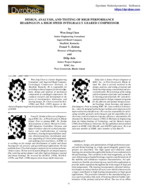Papers
“Design, Analysis, and Testing of High Performance Bearings in a High Speed Integrally Geared Compressor,” |
Abstract
Analysis, design, and optimization of high performance journal and thrust bearings in a high speed integrally geared compressor are described. The high speed and relatively small bearing size stretches the applicable limits of conventional style tilt pad bearings . The variation in the load magnitude, as is the case with most gear loaded bearings, requires careful analysis of the stability and unbalance response characteristics. An optimized new flexible pivot bearing was used in this application to provide stable operation throughout the wide ranges of load and inlet temperature. The bearing incorporated a directed lubrication feature to reduce the hot oil carry over which is known to be a major contributor to high bearing temperatures in high speed applications . The precision inherent in the manufacturing process used to produce this style of bearing allowed further optimization of the preload and pivot offset. The use of an offset pivot configuration demonstrated lower sensitivity to bearing clearance variation.
The necessity for high rotational speeds in integrally geared compressors increases the frictional power losses in the journal and thrust bearings. The parasitic losses constitute a significant percentage of the overall bearing power losses. Bearing designs that were utilized to reduce both the frictional and parasitic losses in the thrust bearings are discussed. The new thrust bearings were designed to provide an optimum crown-to-film thickness ratio allowing the bearing to carry the design thrust load with fewer pads. The analytical results for the conventional and deflection journal and thrust bearings are presented and compared to the test data. The new bearing resulted in lower steady state vibrations. At surge conditions, the synchronous and subsynchronous vibrations were about 25 percent of the conventional tilt pad bearing. The frictional and parasitic power losses with the new thrust bearing were about 20 percent lower than those of the conventional bearings. The temperature rise was also lower which indicated that the inlet temperature can be further increased with the new bearing allowing a wider operating temperature range and lower frictional losses.

